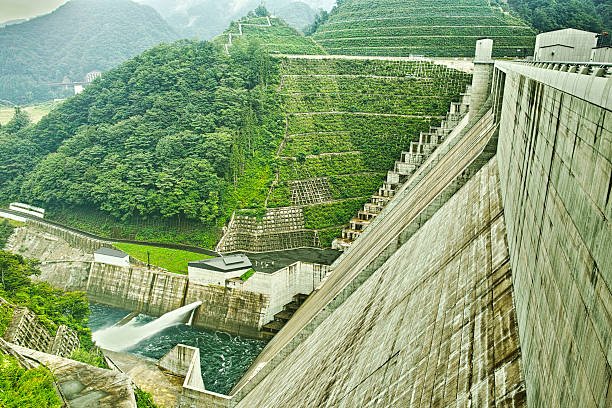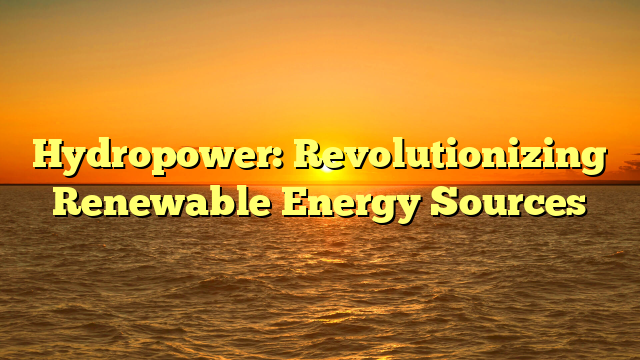Hydropower
In an age the place the local weather disaster looms massive and the demand for sustainable power sources accelerates, hydropower stands out as a cornerstone of the renewable power revolution. Harnessing the ability of flowing water, hydropower not solely contributes considerably to lowering carbon emissions but additionally guarantees power safety for nations across the globe. This text delves into the fascinating world of hydropower, exploring its historical past, expertise, advantages, challenges, and future potential.
The Historical past of Hydropower
The roots of hydropower hint again centuries. Early civilizations utilized water wheels to mill grain or carry out mechanical work. Nonetheless, the fashionable period of hydropower started within the late nineteenth century with the arrival {of electrical} turbines. In 1882, the primary hydropower plant in the US was in-built Appleton, Wisconsin, marking a pivotal second in electrical energy era.
Since then, hydropower has advanced technologically and expanded its footprint worldwide. At this time, large-scale hydropower crops generate vital parts of electrical energy in lots of international locations, successfully laying the inspiration for a sustainable power infrastructure.
How Hydropower Works
At its core, hydropower converts the kinetic power of flowing water into mechanical power, and subsequently into electrical power. This is a simplified breakdown of the processes concerned:
1. Water Move
Water is usually saved in a reservoir behind a dam. The potential power saved on this elevated water is essential for the power-generating course of.
2. Turbine Motion
When water is launched, it flows by means of generators. The drive of the water spins the turbine blades, changing the water’s kinetic power into mechanical power.
3. Producing Electrical energy
The spinning generators are linked to a generator. Because the generators flip, they trigger the generator to supply electrical energy, which might then be transmitted to energy grids and houses.
4. Vitality Storage
Hydropower crops can even incorporate pumped storage. Throughout low demand, extra electrical energy is used to pump water again into the reservoir, permitting it to be launched later to satisfy peak demand.
Kinds of Hydropower Crops

Hydropower is available in numerous varieties, every suited to completely different geographic and financial situations.
1. Run-of-River Techniques
These techniques make the most of the pure movement of rivers with minimal storage in a reservoir. They’re much less disruptive to native ecosystems and infrequently have a smaller environmental footprint.
2. Reservoir-Primarily based Techniques
These conventional hydropower crops depend on massive dams that create substantial reservoirs. They will retailer power for peak demand durations and are able to producing vital quantities of electrical energy.
3. Pumped Storage Services
Pumped storage techniques act like batteries. They retailer power within the type of water by shifting it to a better elevation when demand is low, then releasing it when demand spikes.
The Advantages of Hydropower
Some great benefits of hydropower lengthen past simply electrical energy era.
1. Renewable and Sustainable
Hydropower is taken into account renewable as a result of it depends on the Earth’s water cycle. So long as rain falls and rivers movement, we are able to harness this power.
2. Low Greenhouse Fuel Emissions
In comparison with fossil fuels, hydropower crops produce minimal greenhouse gases. This makes them very important gamers within the combat in opposition to local weather change.
3. Vitality Storage and Stability
Hydropower crops can quickly modify output, offering dependable energy and stabilizing grids affected by intermittent renewable power sources, like wind and photo voltaic.
4. Financial Advantages
Hydropower creates jobs throughout building and upkeep and stimulates native economies. Typically, it gives inexpensive electrical energy to communities that might in any other case depend on dearer power sources.
5. Flood Management and Water Provide
Dams related to hydropower can be utilized for flood management and will help with irrigation, guaranteeing water provide throughout dry durations.
Challenges Going through Hydropower
Whereas hydropower presents quite a few advantages, it additionally faces sure challenges:
1. Environmental Affect
Giant hydropower tasks can disrupt native ecosystems, fish populations, and communities. The flooding of land for reservoirs can result in habitat loss and dislocation of individuals.
2. Local weather Vulnerability
Hydropower era is reliant on water movement, which will be affected by local weather change. Altered precipitation patterns can result in durations of diminished water availability.
3. Excessive Upfront Prices
The preliminary funding for hydropower infrastructure is substantial. This could deter personal investments and is commonly a important challenge for growing areas.
4. Regulatory Hurdles
Regulatory processes to approve new tasks will be extended, which can delay the implementation of latest hydropower services.
The Way forward for Hydropower
As we glance forward, hydropower is poised to play an much more vital position within the renewable power panorama. Improvements in expertise, akin to small modular hydropower techniques and enhancements in turbine design, are making it simpler to harness power at a decrease environmental value.
Transitioning to Extra Sustainable Practices
The main target is shifting in direction of integrating sustainable practices in hydropower improvement. This contains:
-
- Ecological Engineering: Designing dams that permit for fish passage and minimizing ecological disruption.
-
- Neighborhood Involvement: Partaking native communities within the planning course of to make sure their wants and considerations are addressed.
-
- Hybrid Techniques: Combining hydropower with different renewable sources, like photo voltaic and wind, to boost effectivity and resilience.
International Growth and Funding
With the worldwide push in direction of net-zero emissions, nations are more and more investing in renewable power, together with hydroelectric energy. Rising applied sciences are being explored, akin to underwater generators and kinetic power captured from ocean currents, which broadens the scope of hydropower past conventional strategies.
Actionable Insights
As we try to embrace clear power, listed below are some actionable insights encouraging a larger dedication to hydropower:
-
-
Help Native Initiatives: Advocating for community-based hydropower tasks can catalyze broader acceptance and funding in renewable power.
-
-
-
Be Knowledgeable Voters: Have interaction in discussions about power coverage and help laws selling renewable power sources, together with hydropower.
-
-
-
Discover Revolutionary Applied sciences: Spend money on or find out about rising hydropower applied sciences that align with sustainability objectives.
-
-
-
Advocate for Sustainable Practices: Help practices that decrease the environmental affect of hydropower, akin to ecological assessments and fascinating native stakeholders.
-
-
- Keep Educated: Comply with the newest analysis and developments in hydropower to grasp its evolving position within the power panorama.
Conclusion: Embracing Hydropower’s Potential
In conclusion, hydropower stands out as a formidable participant within the renewable power enviornment, with the potential to considerably revolutionize how we generate, retailer, and devour power. By recognizing each its advantages and challenges and taking proactive steps, we are able to harness hydropower’s full potential for a sustainable future. As we deal with the quandaries of local weather change and power demand, the significance of a diversified power portfolio, with hydropower at its core, turns into crystal clear. Collectively, we are able to pave the best way for a cleaner, greener world powered by renewable power.







